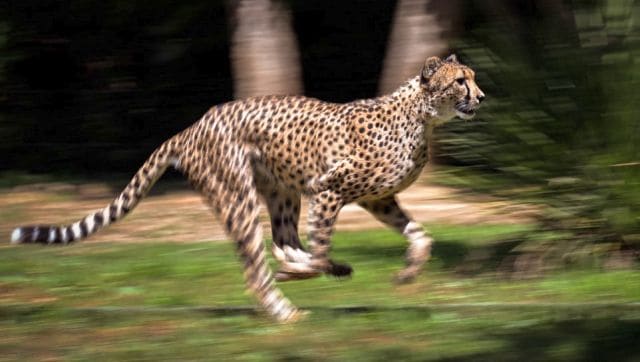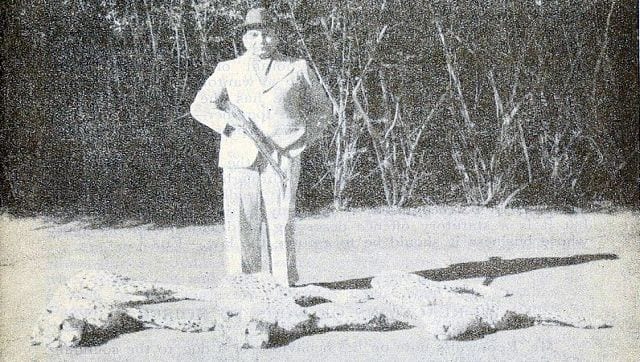There’s some good news for wildlife enthusiasts. India is one step closer to bringing cheetahs , the world’s fastest animal, back home after they went extinct in the country since 1952. On Wednesday, the Narendra Modi government inked a memorandum of understanding (MoU) with Namibia to bring cheetahs to the country, with the first batch of eight wild cats set to arrive by 15 August. The plan to bring African cheetahs to India has been decades in the making, and Union Environment Minister Bhupender Yadav called the pact “historic”. We take a closer look at the plan of reintroducing the big cat in India after decades and also examine the reason why the cheetah had gone extinct from the country. The cheetah plan On Wednesday, Minister of Environment Forests and Climate Change, Bhupender Yadav and the Deputy Prime Minister and Foreign Minister of Namibia, Netumbo Nandi Ndaitwah inked a deal that will see four male and as many female African cheetahs being flown in from Namibia next month — a move expected to coincide with India’s 75th Independence Day celebrations.
Happy to share that India has signed a historic MoU with Namibia to promote Wildlife Conservation and Sustainable Biodiversity Utilization. The MoU seeks to promote conservation and restoration of cheetah in their former range from which the species went extinct. pic.twitter.com/MNVyw8S2eQ
— Bhupender Yadav (@byadavbjp) July 20, 2022
According to the pact, the two countries will share and exchange expertise and capacities to promote cheetah conservation in their ranges. They will collaborate in areas of climate change, environmental governance, environmental impact assessments, pollution and waste management etc and undertake an exchange of personnel for training and education in wildlife management, including sharing of technical expertise, wherever relevant. Also read: Saving cheetahs from going extinct, one cub at a time The government has said that funding for the project will come from the Ministry of Environment, Forest and Climate Change (MoEFCC) and the National Tiger Conservation Authority (NTCA), supplemented by private finance through corporate social responsibility (CSR). The cheetahs will arrive in India for a one-year trial period. NTCA additional director general (Project Tiger) and member secretary, SP Yadav, told Hindustan Times they are trying to get the cheetahs to the country by 15 August to mark the country’s 75th Independence Day. “This is an historic event. After a 75-year gap we will see cheetahs back in India. This will be the first intercontinental wild-to-wild transfer of cheetahs in the world. Some concerns regarding the agreement were there, but those have been resolved now. Negotiations on modalities of translocation are underway. Initially, we may get eight cheetahs by August,” said Yadav. [caption id=“attachment_10937611” align=“alignnone” width=“640”]  Indian officials are hoping to complete the first transfer of the cheetahs by 15 August to coincide with India’s 75th Independence Day celebrations. AFP[/caption] Kuno, cheetahs’ new home As per the plan, the eight cheetahs will be housed at Kuno-Palpur National Park in Madhya Pradesh’s Sheopur district. Incidentally, Kuno was home to Asian cheetahs over 100 years ago. The current carrying capacity of the Kuno National Park is 21 cheetahs. The capacity can be enhanced by including the remaining part of the Kuno Wildlife Division (1,280 sq km) through prey restoration, the ministry said. What is unique about Kuno are the small pockets of grasslands that are found within the park. The grasslands are quite reminiscent of the African Savanna, making it a suitable habitat for lions and other cats. Devoid of human settlements, also makes Kuno a good choice for the cheetahs translocation project. Kuno was selected for the cheetah reintroduction project after other sites such as Mukundara Tiger Reserve, Shergarh Wildlife Sanctuary, Gandhi Sagar Wildlife Sanctuary, Madhav National Park and Nauradehi Wildlife Sanctuary were examined. According to ecologist Ghazala Shahabuddin, Kuno was picked as this was because the area had a large habitat area available and significant investments had already been made to displace the villagers inhabiting the site. [caption id=“attachment_10937591” align=“alignnone” width=“640”]  The eight cheetahs will be housed at Kuno-Palpur National Park in Madhya Pradesh for a trial period of one year. AFP[/caption] Plan in the pipeline for many years The reintroduction of cheetahs in the country has been a work of many decades. In the 1970s, Indira Gandhi was very keen on bringing back the cheetah and the Department of Environment formally wrote to the Iranian government to request Asiatic cheetahs in use for reintroduction and apparently received a positive response. Unfortunately, those talks were stalled as an Emergency was soon declared in the nation and the Shah of Iran fell from power. In 2009, the issue was rekindled and it was decided that the African cheetah would be used for introduction to India. The issue got further impetus in September of the same year when the Ministry of Environment & Forests, through the Wildlife Institute of India (WII), organised a meeting in Gajner, Rajasthan, to discuss the issue. The meeting was jointly organised by the WII in association with the Wildlife Trust of India (WTI), a prominent NGO based in Delhi. The Cheetah Conservation Fund, International Union for Conservation of Nature and other NGOs were represented as were high-ranking officials of several state forest departments. Ten sites in five central states were surveyed and Kuno national park in Madhya Pradesh emerged as the top choice. However, in 2010 the plan hit a roadblock when the stayed the order to reintroduce cheetah to Kuno-Palpur because the National Board for Wildlife had not been privy to the matter. The court said that priority should be given to the reintroduction of the Asiatic lion, which is only found in Gir National Park, Gujarat. Ten years later, in 2020, the apex court allowed the Centre to introduce the African cheetah to a suitable habitat in India. Former Environment Minister Jairam Ramesh, who had envisaged the programme, had welcomed the decision. “It is a momentous occasion." Finally, on 6 January 2022, Union Environment Minister Bhupender Yadav launched the action plan saying, “The cheetah that became extinct in independent India, is all set to return.”
The cheetah that became extinct in independent India, is all set to return.
— Bhupender Yadav (@byadavbjp) January 5, 2022
Launched an action plan for reintroduction of cheetah in India at the 19th meeting of the National Tiger Conservation Authority. pic.twitter.com/Gs5k0ktMUb
When cheetahs went extinct The cheetah is the only large carnivore that has got completely wiped out from India, primarily due to hunting and habitat loss. It has been said that during the rule of the Mughal emperor Jahangir, there were 10,000 cheetahs across the country, including 1,000 of them in his court. A BBC report states that between 1799 and 1968, there were at least 230 cheetahs in the wild in India. However, hunting is the primary reason for the disappearance of the wild cat from the Indian grasslands. The animal was hunted for bounty and sport. Later, during the British Raj, a large number of cheetahs were killed through bounty hunting because the cats were entering villages and killing livestock. It is widely believed that in 1947, Maharaja Ramanuj Pratap Singh Deo of Koriya, Surguja, in what is today known as Chhattisgarh, shot dead the last three recorded Asiatic cheetahs in India. In 1952, the Asiatic Cheetah was declared extinct in India. [caption id=“attachment_10937401” align=“alignnone” width=“640”]  Maharaja Ramanuj Pratap Singh Deo of Koriya, Surguja shot three of the last cheetahs in India in 1948. Image Courtesy: Bombay Natural History Society[/caption] Concerns over reintroduction The reintroduction plan is fraught with risks and conservationists have also expressed their concerns. Ravi Chellam, wildlife biologist and conservation scientist, in an Outlook column wrote that introducing the big cat from Africa “will distract our attention from other pressing and critical conservation priorities.” He writes, “The cheetah introduction plan has never figured in our National Wildlife Action Plan including the current plan for the period 2017-2031, while the translocation of lions has been a national priority since the 1950s. India has several charismatic and highly endangered species, eg, Caracal, Great Indian Bustard, Wolf, Lesser Florican and Blackbuck, which are denizens of open forest, Savanna and grassland systems. We have been failing badly in conserving these species and their habitats. The resources to be expended, estimated at Rs 40 crore for the first five years, for introducing African cheetahs could be better spent on our existing native species.” Conservationists also note that cheetahs need large home ranges - ideally habitats ranging between 5,000 and 10,000 sq km. Dr K Ullas Karanth, one of India’s top conservation experts, told BBC that these habitats must be “people free, dog free and leopard or tiger free” with enough wild prey for the cat. He says most of India’s former cheetah habitats are shrinking because of pressure on land. “The purpose of a reintroduction has to be to grow a viable population with dozens of cheetahs breeding in the wild. Just dumping some animals in the park will not help. This is a doomed project,” he told BBC. Conservationists also argue that Kuno might not be a favourable spot as there is no data that shows that cheetahs, lions, tigers and leopards can coexist comfortably in the same habitat. It has never occurred anywhere else before, so there is no real-life experience to draw upon. With inputs from agencies Read all the Latest News , Trending News , Cricket News , Bollywood News , India News and Entertainment News here. Follow us on Facebook, Twitter and Instagram.


)

)
)
)
)
)
)
)
)



